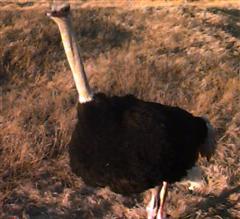Ostrich - Blue Necked
Scientific Name: Struthio camelus molybdophanes
Sat, 12th July, 2025 - 8:23 am GMT
Sponsor Ads:

Alternative Name
Scientific Name: Struthio camelus molybdophanesBasic Info
The Blue Necked Ostrich can reach up to eight feet in height and weighs between 250 and 350 pounds. They are generally smaller than the Red Necked Ostrich, but larger than the African Black. They have only two toes on each foot, the only bird with this unique characteristic. They have long, powerful legs, which can carry them at speeds up to fifty kilometers per hour and make great weapons. The neck and lower extremities are naked and have a blue-tone. The male has black feathers and a white tail, while the female has grayish-brown feathers. They have small, flat heads with long eyelashes and large eyes.
Health
Like other ostriches, the Red Necked Ostrich requires a lot of space. Chicks should have at least 40 square feet per chick, while adults should be given least 200 yards in a rectangular shape so they can reach full running speed. Some ostrichs may be prone to having crooked legs, but this can be avoided with proper diet and exercise. Breeding In the wild, the Blue-Necked Ostrich mates in July. The males usually meet with about four females. The males are also responsible for building the nest, into which the female lays a single egg. Female ostriches can lay up to seven eggs in a two-week span. The eggs are quite large, weighing about three pounds each. Ostriches move in a sort of harem, with several females to each male. The dominant female incubates the eggs during the day and the male sits on them at night. Breeding is done regularly in captivity, though hatching and raising chicks may prove difficult. In captivity the breeding season usually occurs during warm months with longer days. A hen will lay an egg every other day for up to 18 to 20 days on average and then she will stop for a couple of weeks. She will start again if the eggs are removed from the nest for hatching in an incubator. Hens can lay up to 100 eggs in a season, but most lay 40 to 60 eggs. Chicks are mature at 6 months of age, but do not reach their full adult size until they reach 18 to 24 months of age. It should be noted that males will become aggressive during breeding season. Generally, they are only aggressive to other males.Habitat
N/ABehavior
The Blue Necked Ostrich is one of two species of ostriches native to Africa. The Blue-Necked Ostrich lives in the deserts and savannas of southeastern Africa and southern Egypt. They are powerful animals, with long legs that enable them to sustain speeds of up to 50 kilometers per hour for as much as half an hour. Blue-Necked Ostriches live in groups of between 10 and 15 animals, when they are not breeding. The call of the Ostrich sounds like a hissing roar. They have excellent eyesight, enabling them to use their speed to escape from approaching predators like lions and humans. If one wants to keep ostriches, they must be sure never to wear jewelry or glasses around them. They adore small and shiny things and can steal the glasses off someone's face and swallow them very quickly. During the mating season, males are territorial and may be aggressive. If one male intrudes on the domain of another, the intruded upon threatens the usurper by raising his wings and waving them back and forth in a demonstration called a "display." The males also give loud, roaring calls and inflate their necks while guarding their territory. Other than the territorial behavior shown by males during breeding seasons, the ostrich is no more aggressive than Emus or Rheas. They may be a bit more intimidating to some, however, because of their larger size.Origin
AfricaHistory
Up until the 19th century, Blue Necked Ostriches were quite common. At that time, however, European settlers discovered that the Ostriches plumes made great decorations. Their meat was good to eat, their hides made good leather and their eggs made great omelets. Although they are still relatively common, their population has decreased greatly. One breed, which lived in the Middle East, has been extinct since 1966. It should be noted that in the United States, most of the Ostriches kept in captivity are combinations of the three main groups, African Black, Red Necked and Blue Neck.Common Foods
N/ASponsor Ads:
Live every day as though it were your last. One day, you'll be right. -- Unknown
Ostrich - Blue Necked
Coded by: BGID® | ALL RIGHTS RESERVED Copyright © 2000-2025
Disclaimer | Privacy | Report Errors / Contact | Credits










